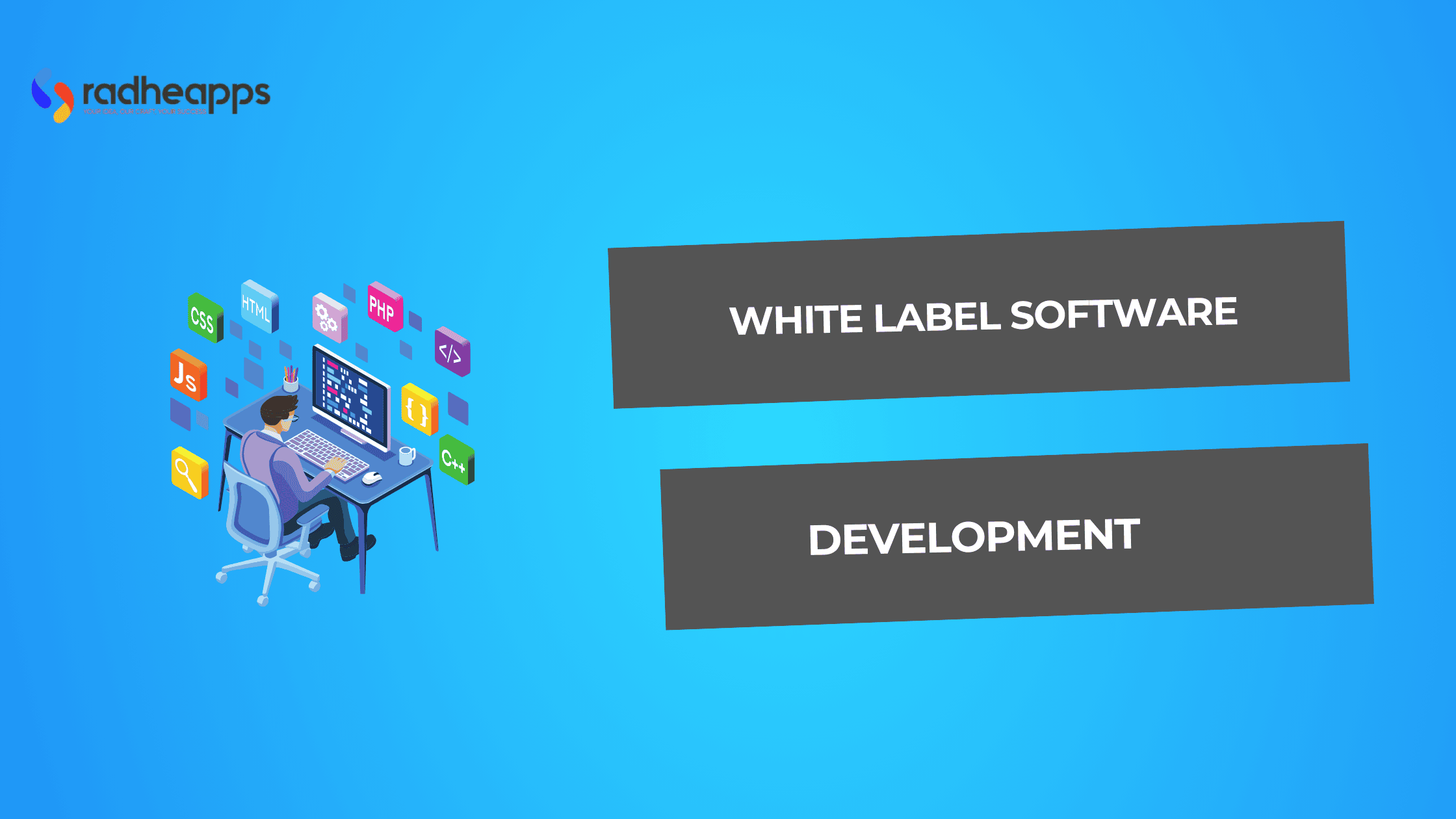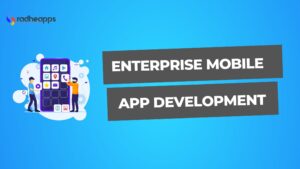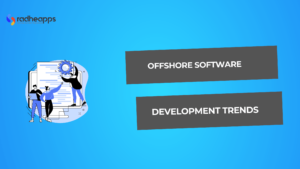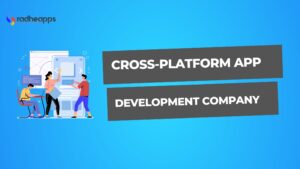According to SPEC INDIA, 42% of businesses have adopted white-label solutions to automate processes and expand their service offerings quickly in 2024.
While traditional software requires technical expertise, it takes expensive planning and development time, and the lofty cost creates barriers for smaller businesses. This is where the white-label software solutions tackle all the disadvantages of traditional software, and it also has its benefits.
Looking for a fast and reliable app with robust security features? Radhepps has got your back. Most traditional apps have generic features that fail to address specific business requirements. We create custom apps for businesses according to their unique challenges. Our apps are highly secure, scalable, and future-ready.
Custom apps produce greater ROI because they feature specific business needs. However, finding the right one can be challenging. That is why, right now, you can get a FREE 30-minute consultation call. Join the call, and let’s discuss how we can help with the unique software for your business.
Book a FREE 30-minute consultation to turn your concept into an interesting story
What is a White Label Software?
White-label software is essentially a product created by a developer (the producer) that other companies (the resellers) can brand and market as if they developed it themselves. The term “white label” originates from using a blank label that can be filled in with the reseller’s branding.
Here is how it works:
Development: Company X creates the software.
Rebranding: Company Y licenses the software, adds its branding, and resells it to customers.
End users: consumer Z buys the software under Company Y’s brand name, unaware of its original developer.
Mailchimp and Stammer.ai are some examples of white-label software services.
Benefits of White Label Software Development
If you want to enhance your offerings without adding yourself to the complexities of creating software from scratch, Here are eight benefits you will get:
Cost-Effectiveness
- White-label solutions cut out the heavy research, development, and testing processes.
- This allows them to invest less in their businesses at the outset and still get a viable product to market.
- Thus, it reduces the capital expenditures required to build in-house custom software.
Time Savings and Faster Launch
- These solutions are pre-packaged and ready for deployment, which reduces the time to market dramatically.
- Companies bypass lengthy development cycles and can introduce their product or service into the marketplace faster, which is crucial in fast-paced markets.
Deep Branding and Customizability
- Businesses can use the software with their branding elements such that it would look like they developed it.
- This ability allows organizations to maintain their brand identities using existing technology.
Reduced Risk
Established white-label products reduce the risk involved in untested software development, which can be avoided. Solutions usually come with a track record, which minimizes the chances of budget overruns and delays.
Maintenance and Support
- The original developers do Ongoing maintenance and updates, which saves businesses from software upkeep burdens.
- Companies can concentrate on marketing and customer engagement instead of technical support.
Scalability
White-label software can be easily scaled to meet growing business needs without requiring large additional resources or hiring specialized staff. This is most rewarding for small to medium-sized enterprises.
Increased Revenue Opportunities
White-label products can generate more revenue streams through additional offerings by extending your services. This reduces overheating, which traditionally happens when developing software.
Expert Knowledge Utilization
Such firms benefit from high-quality solutions offered by specialized developers, which enables businesses to tap the best available technology without needing internal technical expertise.
How Does White Label Software Development Work?
White-label software development is a streamlined process that allows businesses to offer software solutions without creating them from scratch. Here’s how it works:
Initial Consultation
The process begins with a detailed discussion between the client and the development team. This phase focuses on understanding the client’s vision, objectives, and specific requirements for the software product.
Proposal and Scope Definition
After developing the idea, the development team delivers a proposal that contains the project scope, cost estimation, and timelines. Thus, both parties have clear expectations before proceeding further.
Development
The actual development can involve customizing an existing software solution or building from scratch based on pre-defined templates. The developers will apply agile methodologies so that flexibility and responsiveness are evident in this stage.
Customization and Branding
Once the core product is ready, it gets customized according to the client’s brand. This involves changing the visual elements such as logos, color schemes, and user interfaces to ensure the software mirrors the client’s brand identity.
Testing and Quality Assurance
Testing is done carefully to ensure the software works correctly and meets quality standards. This step is essential for identifying bugs or issues before launching.
Deployment
The software is implemented after successful testing. The development team usually hosts on secure servers so the clients do not incur costly infrastructures.
Ongoing Support and Maintenance
The development team typically offers the following services: support and maintenance, which are continued even after implementation. This relieves the burden from clients lacking the technical expertise or resources to manage these aspects.
Revenue Generation
Clients can then market and sell the white-labeled software as their own. This way, the revenue may be generated without investing in significant development processes.
Types of White Label Software Development Solutions
White-label software development solutions consist of a variety of solutions. Each of these is focused more on different spaces. Here are nine of them:
Marketing Automation Software
Marketing automation software enables enterprises to automate marketing and execute campaigns, segmented email, social media posting, etc.
Examples: Active Campaign and Mailmunch offer all the necessary tools for advanced management of marketing workflows and analytics.
Social Media Management Tools
The white-label solutions under this category enable agencies to operate many social media accounts, schedule posts, and track engagement metrics using their branding.
Examples: SocialPilot and Vendasta are two of them that fall under this category.
E-Learning Platforms
E-learning platforms help organizations create online courses and deliver them as if they were doing it themselves.
Examples: Thinkific and TalentLMS offer strong features for creating courses, managing students, and creating a community.
E-commerce Solutions
White-label e-commerce platforms enable companies to establish an online store quickly without developing complicated systems.
Examples: Shopify and Magento have customizable storefronts that resellers can use to brand their products.
Customer Relationship Management (CRM) Software
CRMs help businesses manage customer interactions and data at every stage of the customer lifecycle.
Examples: AllClients and GreenRope allow agencies to offer these services under their brand.
Analytics and Reporting Tools
These solutions give companies the power to produce analytics-based reports and insights.
Examples: Zoho Analytics has both standalone and embedded analytics that can be used to cater to various business requirements.
Chatbot Solutions
There is a growing need for customer support and engagement through chatbots.
Examples: WotNot helps businesses to launch branded chat solutions that increase customer interaction capabilities.
Website Builders and Funnel Creation Tools
There are website builders and funnel building tools which allows users to create customized web experiences while presenting the platform as their own.
Examples: Simvoly is one of the examples.
Payment Management Systems
This type consists of white-label payment processing, which enables businesses to manage subscriptions, transactions, and billing under their brand.
Example: Paddle.
White Label Software Development: Step By Step Process
White-label software development is a process that follows a structured procedure that allows businesses to create customizable software solutions that can be rebranded and marketed as their own.
Here is the step-by-step breakdown of the typical process involved in white-label software development:
Research and Ideation
Understand the target audience and market demands.
Identify key functionalities and features that the software should include. This ensures it meets user needs and can be further customized.
Prototyping and UI/UX Design
Develop wireframes and prototypes to visualize the user interface (UI) and user experience (UX.)
This step is crucial for gathering feedback early in the process. Which ensures that the design aligns with current trends and usability standards.
Backend Development
Build a robust backend using reliable Node.js, PHP, or MySQL technologies.
It should support various customizations, which allows clients to add unique functionalities as needed.
Frontend Development
Create the client-facing part of the software using frameworks like React.js or Angular.
This step focused on ensuring users have an engaging and intuitive experience when interacting with the software.
Testing and Quality Assurance
Conduct thorough testing to ensure the software is bug-free and performs well across different devices and platforms.
Quality assurance is essential to meet client expectations and provide a reliable product.
Customization Capabilities
Once you have developed the core product, focus on customization options for clients.
This includes allowing them to add branding elements such as logos, colors, and specific features tailored to their business needs.
Deployment
Prepare for deployment by integrating the software into the client’s systems.
This often involves collaboration with the client to ensure a smooth launch process, minimizing disruptions during implementation.
Ongoing Support and Maintenance
Provide continuous support and maintenance post-deployment. This includes handling updates, security monitoring, and troubleshooting issues.
All this maintains customer satisfaction and product reliability over time.
Key Advantages for Agencies and White-label Developers
Software development offers several benefits. That is why 73% of businesses incorporate white-label solutions into their workflow. Here are the key benefits:
Key Advantages for Agencies
Cost Efficiency
Agencies can save significantly on development costs by purchasing pre-built software solutions instead of investing in custom development.
This allows them to offer price competitiveness to the clients while sustaining a healthy margin.
Faster Time to Market
White-label solutions allow agencies to launch products quickly because they can be used as is with minimal alterations.
This is a competitive advantage since agencies can respond quickly to market demands.
Access to Expertise
White-label providers allow agencies to access expertise and the latest technologies without having to employ full-time experts.
This improves the quality of services that agencies can offer their clients.
Brand Customization
Agencies can even rebrand the white label product with their logo and branding elements so that there is a continued consistency of branding, yet it can expand service offerings.
Scalability
White-label solutions enable agencies to scale up their services without the hassle of hiring or laying off staff due to peak demand.
This flexibility becomes especially useful in periods of peak demand.
Focus on Core Business
When agencies outsource their software development, they can focus on their core competencies, like marketing and customer engagement.
This reduces the diversion of resources to software creation.
Key Advantages for Developers
Increased Revenue Opportunities
Developers can create multiple revenue streams by selling white-label solutions to various agencies, which lets them expand their market reach without significant additional investment.
Reduced Risk
Software development from scratch involves inherent risks, including potential market rejection. White label offers proven products, which minimizes the risk associated with new product launches.
Streamlined Development Process
Developers can improve existing products instead of starting from scratch, which saves time and resources while making the product quality better through iteration.
Market Validation
The white-label solutions provided by the developers can test their products in different markets through various agencies. This gave them valuable feedback and insights to inform future developments.
Continuous Improvement and Updates
Developers maintain and upgrade the core product. So, the benefit of features and improvements automatically flows to all clients without having to make a further effort from the agencies.
Challenges in White Label Software Development
White-label software development has numerous advantages. However, it also has some drawbacks that a business needs to sail through. The main challenges related to white-label software development are given below:
Lack of Uniqueness
One challenge is that companies may use similar underlying templates or codebases. This can mean there isn’t much variation in the marketplace, which makes it harder for companies to differentiate themselves from their competitors.
Limited Customization Options
Pre-defined features and limitations in customization often characterize white-label solutions. Such restrictions may not allow businesses to customize the software to meet specific needs or represent their brand appropriately.
Dependency on Vendor
The business’s dependence on the white label solution provider for continuous support, updates, and maintenance makes it vulnerable. If the vendor’s service is not up to standard or the vendor suffers from a problem, then the software’s performance will also be affected.
Potential for Brand Dilution
Brand dilution is more likely when multiple businesses in the same industry use similar white-label products. Users get confused and devalue the brand associated with the app.
Support and Maintenance Issues
It is possible to have bugs, security vulnerabilities, or compatibility issues related to support and maintenance. Such issues must be solved on time so that the software functionality does not stop working.
Scalability Limitations
Many white-label solutions are not built for large-scale scalability. As the business grows, it may encounter limitations that prevent it from growing along with the market’s growing demands or needs.
Branding Challenges
When you implement a white-label solution, you will often find it difficult due to brand integration issues. Software may not fully align with a company’s branding strategy, disjointing the user experience.
Hidden Technical Threats
Underlying technical vulnerabilities or limitations that may be hidden in a white-label solution are also found. Unforeseen later challenges or security risks may result from these hidden issues.
Competitive Landscape
With white-label solutions open to several businesses, competition increases as companies offer similar products or services. Saturation might make it difficult for a single business to capture market share effectively.
White Label Software Development vs. Custom Software Development
Businesses often face this dilemma in the decision phase of software solutions, such as whether to opt for white-label or custom software development. Each approach has its unique advantages and disadvantages. Both options are compared as follows:
| White Label Software Development | Custom Software Development |
| They are cost-effective. | This requires a higher upfront cost. |
| Their time-to-market is quick, and so is the launch. | Longer development timelines delay product launch here. |
| It requires less technical expertise. | Here, it requires technical expertise. |
| Here, you will get limited customization. | Here, you will get complete control over customization. |
| This has a scalable issue. | This is scalable. |
How to Choose the Right White Label Software Partner
The right white-label software partner is a critical decision that can significantly impact the success of your business.
Here are some key considerations to help you make an informed choice:
Quality and Customization
Evaluate the quality of the software solutions that the prospective partners offer. Ensure their product can be customized to meet your branding and specific business needs to avoid cookie-cutter solutions that may not align with your goals.
Industry Expertise
Look for partners with a proven track record in your industry or a related field. Their experience can provide valuable insights into market trends and customer preferences, which enhances the overall quality of the partnership.
Scalability and Flexibility
Evaluate whether the white-label solution can grow with your business. A good partner should offer scalable solutions that adapt to changing market conditions and evolving business needs.
Technology Stack and Integration
Ensure that the partner’s technology stack is compatible with your existing systems. Smooth integration can save time and resources, which makes the implementation process more efficient.
Support and Training
Ask about the level of support and training provided by the partner. Comprehensive onboarding processes and ongoing assistance are crucial for successful implementation and operation.
Transparency and Communication
A transparent partner will openly communicate about their capabilities, the project’s progress, and any challenges that may come up. Look for partners who prioritize clear communication to build trust and collaboration.
Pricing Structure
Understand the pricing model, including upfront costs, profit margins, and any additional fees. Ensure that the financial arrangement aligns with your budget while providing value/
Client References and Reputation
Ask for references and testimonials from previous clients to assess the credibility and service quality of the partner. A good reputation usually suggests a reliable partner.
Cultural Fit
Evaluate the work culture and values of the potential partner. A good cultural fit may ensure easier collaboration. This includes communication styles and flexibility in meeting unique requirements.
Legal and Compliance Considerations
Review all legal agreements carefully. This ensures they comply with relevant regulations and protect your interests in the partnership.
Frequently Asked Questions (FAQs)
How does white labeling differ from outsourcing?
The main difference is that White labeling is when one company takes a product or service created by another company and then sells it with its own brand name.
In contrast, outsourcing involves delegating a particular task or service to vendors outside the business.
What industries commonly use white-label software?
E-commerce, digital marketing, education, healthcare, and finance are some of the industries that commonly leverage white-label software services.
How can I ensure data security with a white-label solution?
Selecting a reputable software solution. Verifying that the software includes all robust security measures. Outlining data ownership and usage rights in your contract and conducting regular security audits and assessments of the white-label solution. These are some of the essential measures you have to take if you want to secure your data.
Conclusion
White-label software development provides a strategic route for companies that want to expand their services but do not wish to go through the hassle of developing software.
Businesses that leverage existing solutions can significantly reduce their development time and cost. Thus, they retain the ability to customize and brand the software as their own simultaneously.
This leads to innovation that leads businesses to concentrate on their core competencies to achieve growth and profitability. By understanding the challenges and opportunities offered by white-label solutions, organizations can be best positioned for success while providing superior value to clients.
If you are in a business phase where you cannot concentrate on your core business functions and do not have enough time to build a team, train them, and fully develop your software, Radheapps can do it for you.
We develop software for startups and enterprises. We not only develop quality software but also do it cost-effectively. We’re committed to ‘Achieving Your Goals.’ No matter how complex your software is, we will find the finest solution under timely completion.
Check out some of our previous client’s case studies. If you want to know more, you can book a strategy session with us.
Contact us to discuss your idea and turn it into a digital solution.




